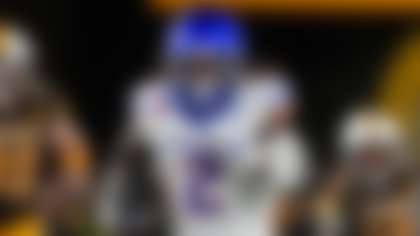At the end, there was a bittersweet last glimpse of the Superdome, a final photo with his children on the turf on which he had transformed New Orleans football, an embrace with one of the few peers who knew firsthand the durability and longevity to which Drew Brees was finally bidding farewell.
Nobody who saw Brees, 42, on the night his Saints lost to the Buccaneers in the Divisional Round had any doubt that he had played his last game. But the protracted official exit allowed for the sharp edges of that final poor performance to dull and be replaced by memories of moments and milestones from a remarkable and unprecedented career. Brees was arguably the greatest free-agent signing in history -- overhauling a franchise, helping to rebuild a city and making himself into a future Hall of Famer in the rarest of NFL acts, absolutely maximizing the second stop in his career.
Brees first heard that he quite literally did not measure up when he was coming out of high school. Despite leading his team to the Texas state championship and an undefeated season, he was not heavily recruited because he lacked the prototypical height of a classic pocket passer. After finishing third in the Heisman Trophy voting at Purdue, Brees stepped onto the scale at the 2001 NFL Scouting Combine and heard the verdict again. He measured at 6 feet and one-eighth or two-eighths inches, his old college coach, the late Joe Tiller, once told me for a story in the New York Times. And Brees started arguing.
"No, measure me again," Tiller remembered Brees saying. "That can't be. I know I'm 6-1."
He was not 6-1 -- he was listed at 6 flat -- and other than the fact that it likely contributed to him being drafted by the San Diego Chargers in the second round instead of the first, his stature hardly mattered. He became an undersized overcompensater, and the doubts about how he would see over offensive linemen became a kind of badge of honor for a player who overcame obstacles real and perceived his entire career to become not just one of the most prolific quarterbacks in history, but one of the game's most unlikely conquerors. His success also changed how the NFL viewed the ability of shorter quarterbacks to play from the pocket, paving the way for people like Russell Wilson, Baker Mayfield, Kyler Murray and Tua Tagovailoa.
That Brees' career overlapped in some or large part with Peyton Manning and Tom Brady meant that he was often, nationally, in their considerable shadows. He was, for instance, never the NFL's Most Valuable Player, despite having five 5,000-yard passing seasons and retiring as the league's all-time passing-yardage leader.
But Brees might have been a better athlete than either of his more prominent contemporaries. As a boy, Brees defeated future tennis star Andy Roddick three times. He nearly played college baseball. He was an outstanding basketball player. He had quick feet.
And he had uncanny accuracy, the cornerstone of a game that, combined with an intelligence level that allowed him to quickly process defenses, bedeviled defenders. Brees owns four of the top five seasons in completion percentage -- his 74.4 in 2018 is the best ever -- and even last season, he finished above 70 percent.
The television show "Sports Science" once measured Brees' accuracy by having him throw footballs at a target. He released the ball from a consistent angle, it traveled at a consistent speed and it revolved at a consistent rate. Brees hit the target that was 20 yards away 10 out of 10 times -- more accurate, the show surmised, than elite archers.
"His arm strength was not the best compared to others like Aaron Rodgers, but his mind and processing ability is insane," said Jacksonville linebacker Joe Schobert. "Playing in a dome with no weather really helps that 7-on-7 feel. When he is cooking, the defensive line has no chance to get to him, because he is getting it out so fast. The coverage is so hard when the quarterback and receiver know exactly where the ball is going."
It was all nearly derailed when, at the end of the 2005 season, his throwing shoulder was wrenched from its socket. It was a brutal injury -- a "1-in-500 injury," he was later told -- a dislocation accompanied by a complete tear of the labrum and a partial tear of the rotator cuff. There was considerable doubt about whether he could play again -- and even if he did, who would have him in this condition? After fits and starts and benchings and the addition of Philip Rivers in 2004, Brees was finally the entrenched starter in San Diego, but he was about to be a free agent after playing the 2005 season under the franchise tag.
All anybody needed to know about Brees could have been learned during his rehabilitation from that injury. He was told by his physical therapist that it would be eight months until he could throw a football again, and two years before he would feel normal. But with each goal -- out of a sling, full range of motion -- Brees beat it. His recovery was simply turbo-charged, ahead of schedule at every step, a testament to Brees' resilience, yes, but also to how much he thrived on competition and doubt. His recovery became so legendary that when Andrew Luck dealt with his own shoulder injury, he asked Brees for advice.
Brees ended up not missing a game, but in between came a series of momentous decisions that shaped the futures of two NFL franchises, all of college football and the careers of one of the greatest players and coaches the game has ever known. The Chargers offered Brees a contract that was heavily based on performance incentives, but with Rivers already on the roster, the writing seemed to be on the wall and Brees tested the market.
There wasn't much there -- laughable now -- but the most interest came from the Miami Dolphins, engaged in a search for an heir to Dan Marino that is still not complete. Nick Saban bemoans what happened next to this day. Saban wanted Brees, but the Dolphins' doctors, worried about Brees' shoulder, advised against signing him. And so the Dolphins traded for Daunte Culpepper instead, arguably one of the biggest and most impactful miscalculations in NFL history. The Dolphins finished the 2006 season at the bottom of the AFC East, Saban left for the University of Alabama -- where he has built a college football dynasty -- and the Dolphins, who have not won a playoff game since that fateful decision, are still, all these years later, not sure they have found their franchise quarterback.
For the Saints, the only other team interested, the Dolphins' decision was a gift. Sean Payton had just arrived as a first-time head coach, and Brees was the quarterback he wanted to run his offense. Brees signed a six-year deal that had much more guaranteed money than the Chargers offered. The success was immediate -- the Saints won 10 games and went to the playoffs in 2006. Remarkably, he led the league in passing yards less than a year after his devastating injury. Three years later, the Saints won the only Super Bowl in their history, a performance that remains a model of Brees' legendary efficiency. He completed 32 of 39 passes for 288 yards, two touchdowns and no interceptions. He was named the game's Most Valuable Player. It was the top of the mountain Brees had been climbing since few were interested in him coming out of high school. He spent the rest of his career doing all he could to get the Saints back to that moment.
In Brees' 15 seasons, the Saints went to the playoffs nine times -- in the 39 years before his arrival, the franchise had been to the postseason five times. Brees did not miss a Saints game because of injury until the 2019 season -- a 14-year stretch -- and his shared understanding of the offense with Payton allowed the Saints to be the most productive offensive machine in the league. In his final season, Brees missed four games after suffering broken ribs and a punctured lung, but when the season was over, his wife, Brittany, revealed that he also had a previously undisclosed torn rotator cuff and torn fascia in his foot.
"He's as courageous and as tough a player I've ever been around, not only physically but mentally," Payton said at the end of the season.
That the Saints won "only" one Super Bowl with Brees, and that they fell short in frequently heartbreaking fashion in recent years, will likely be bemoaned and analyzed for years in New Orleans.
"There's been a couple times when it's been within our grasp," Cam Jordan said after the Saints lost to the Bucs. "And us, as a team, just failed him."
Brees' impact on New Orleans may have meant even more off the field, though, and it is this part of his legacy that deserves attention equal to the records he set and the games he played. Brees joined the Saints in the same season as Payton became the head coach, and their long relationship formed the foundation of the Saints' renaissance. New Orleans had enjoyed a love affair with the Saints that long predated Brees and Payton and, even, winning. But the team and the city were at rock bottom when the quarterback and coach arrived, having barely survived Hurricane Katrina, which drowned the city and inflicted so much damage on the Superdome that the Saints were vagabonds in 2005.
Brees has often said that he and Brittany felt like they had been called to go to New Orleans, and that decision alone boosted the spirits of New Orleanians, who badly needed to believe that someone else thought the city could recover. His Brees Dream Foundation, devoted to improving the quality of life for cancer patients and offering care and education for children in adverse circumstances, has donated millions of dollars to local organizations -- improving housing, rebuilding ball fields, restoring parks, restoring child care facilities. Last year, the foundation donated $5 million for coronavirus relief efforts in Louisiana.
Kansas City Chiefs safety Tyrann Mathieu is from New Orleans. He, like everyone else, knew what those last wistful moments in the Superdome meant was coming. Brees did not play well in his final game -- he threw three interceptions and completed just 55.9 percent of his passes. It was, of course, not the way any player, let alone a future Hall of Famer, wants to leave the field. The entire moment felt wrong, not just because of Brees' final stat line, but because the pandemic meant that the Superdome was not packed with the raucous No. 9-clad fans who could have given Brees the sendoff a beloved legend deserved. Brees already has a lucrative broadcasting contract with NBC Sports, allowing him to immediately move into his second career.
The first left an extraordinary legacy that elevated the game and a region.
"Being from New Orleans Drew Brees meant everything to us in that city ... at many times our only hope, you know to smile & feel good, to live in a winning reality ... that man gave us all life …" Mathieu tweeted, "none of us are perfect but he was close."
Follow Judy Battista on Twitter.












